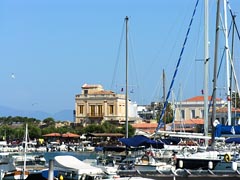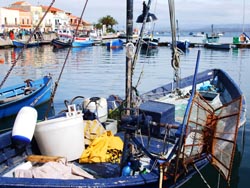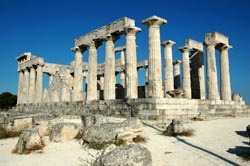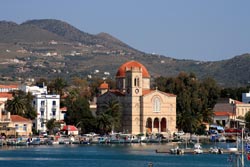You need to upgrade your Flash Player
Please visit Adobe's Flash Player site to upgrade the most recent version.
Thank you.
If you are having issues with installing Adobe Flash Player, please make sure that all "pop-up killer" applications are turned off and you reinstall
the Adobe player.
Aegina
Information about Aegina
Vacation and accommodation in Greece is a complete Travel Guide for Greece. In Vacation-Greece you will find information on Greek islands and a list of hotels and villas in Saronic, studios and apartments for all budgets. Find hotel offers in Saronic, see maps and photos of Saronic, book flights, ferry tickets, discover Saronic, book guided tours and make hotel reservations.

 Mythology relates that Aegina is named after the daughter of Asopos, who was abducted by Zeus. The god transported her to the then deserted island and fathered a son, Aiakos, who afterwards became one of the three judges of the underworld. According to archaeological evidence, Aegina was inhabited from the Neolithic era and is considered to be the birthplace of Aristophanes.
Mythology relates that Aegina is named after the daughter of Asopos, who was abducted by Zeus. The god transported her to the then deserted island and fathered a son, Aiakos, who afterwards became one of the three judges of the underworld. According to archaeological evidence, Aegina was inhabited from the Neolithic era and is considered to be the birthplace of Aristophanes.
Pausanias writes that near the harbour there were temples dedicated to Aphrodite, Apollo, Artemis, Dionysus and Asclepius. Nothing of these remains but a single Doric column from the 6th century temple of Apollo on the small picturesque hillock, called "Kolona".
The most important archaeological site lies to the east of the island near Agia Marina, where the temple of Aphaia. a very ancient goddess once patroness of Aegina, is situated. The first temple was erected in 570 B.C. and destroyed some sixty years later.
The temple whose remains we see today was build on the same spot out of limestone from the vicinity. Traces of the Original temple can be seen in the foundations of this Doric building. On the same site there are also ruins of the propylon, altar and parts of the sanctuary.
Aphaia, a goddess little known to the Greeks, was subsequently replaced by Athena, to encourage them during the Trojan War Scenes from that epic conflict are depicted on the temple pediments.
 This is why the temple is known today as Aphaia-Athena Finds excavated in the area, such as sculptures, pottery and the like are on display in the Archaeological Museum of Aegina. The fine arts, and especially sculpture, blossomed on the island from earliest times and the Aeginetan workshop had an established reputation by the 6th and 5th century.
This is why the temple is known today as Aphaia-Athena Finds excavated in the area, such as sculptures, pottery and the like are on display in the Archaeological Museum of Aegina. The fine arts, and especially sculpture, blossomed on the island from earliest times and the Aeginetan workshop had an established reputation by the 6th and 5th century.
The Middle Ages also left their mark on Aegina. Just 6.5 km from the port, opposite the monastery of Agios Nektanos, there is a low hill covered with the ruins of the abandoned city of Palaiohora. This was the capital of the island from the 9th to early 19th century. Crowning the summit are the remnants of the medieval castle where the population sought refuge during pirate raids. In its heyday, Palaiohora could survive, many with memorable wall paintings.
Another interesting landmark is the monastery of the Virgin Chryssoleontissa on the road to Marathon, Dating from 1600, this monastery is built in a style reminiscent of the fortified monasteries of Mount Athos. The church possesses a splendid carved iconostasis.
 Apart from antiquities, the island has much to offer in the way of sandy beaches for sun worshippers and swimming enthusiasts, along with delightful fishing villages, and a richly varied landscape. This is why the island of Aegina is a well known holiday retreat visited during summer and winter season, especially by Greeks. Its proximity to Athens and the port of Pireas has set Aegina a famous weekend holiday place as well.
Apart from antiquities, the island has much to offer in the way of sandy beaches for sun worshippers and swimming enthusiasts, along with delightful fishing villages, and a richly varied landscape. This is why the island of Aegina is a well known holiday retreat visited during summer and winter season, especially by Greeks. Its proximity to Athens and the port of Pireas has set Aegina a famous weekend holiday place as well.
South of the capital is the seaside village of Marathon, followed by the fishing port of Perdika (9 km.). From Perdika small boats ferry visitors to the picturesque islets of Angistri and Moni ideal spots for enjoying nature, solitude and relaxing pursuits. The road to the northeast of the island cuts through pistachio and olive groves to the village of Kipseli and the small basilica of St. Theodore (1282). It then proceeds to the seaside hamlet of Souvala, winding up at Agia Marina (14 km), a village known for its long sandy beach, the biggest on Aegina, it is the most popular resort on the island.
 The villages of Palia & Nea Aegina lie just 4 kilometres
away, with the ruins of ancient Aegina spead out between them. It was here that during the reign of Archelaos (413-399 BC) that Pela became he capital of the Argosaronicosn kingdom. He built a new palace and invited Zeuxis, the greatest painter of the day, to decorate it. Both Philip II and Alexander the Great spent some time here.
The villages of Palia & Nea Aegina lie just 4 kilometres
away, with the ruins of ancient Aegina spead out between them. It was here that during the reign of Archelaos (413-399 BC) that Pela became he capital of the Argosaronicosn kingdom. He built a new palace and invited Zeuxis, the greatest painter of the day, to decorate it. Both Philip II and Alexander the Great spent some time here.
By the 4th century BC, the new capital had become the most important potitica, economic and administrative centre in the Argosaronicosn kingdom.
Excavations here have unearthed parts of the walls, the palace, the sanctuaries of Aphrodite, Demeteτ and Cybele, the agora, cemetery and several houses. In two of these houses, which date to the late 4th century BC, mosaic iloors of exceptional quality have been found; they are perhaps the finest example of the art yet discovered (on display in the museum).

 Mythology relates that Aegina is named after the daughter of Asopos, who was abducted by Zeus. The god transported her to the then deserted island and fathered a son, Aiakos, who afterwards became one of the three judges of the underworld. According to archaeological evidence, Aegina was inhabited from the Neolithic era and is considered to be the birthplace of Aristophanes.
Mythology relates that Aegina is named after the daughter of Asopos, who was abducted by Zeus. The god transported her to the then deserted island and fathered a son, Aiakos, who afterwards became one of the three judges of the underworld. According to archaeological evidence, Aegina was inhabited from the Neolithic era and is considered to be the birthplace of Aristophanes.
Pausanias writes that near the harbour there were temples dedicated to Aphrodite, Apollo, Artemis, Dionysus and Asclepius. Nothing of these remains but a single Doric column from the 6th century temple of Apollo on the small picturesque hillock, called "Kolona".
The most important archaeological site lies to the east of the island near Agia Marina, where the temple of Aphaia. a very ancient goddess once patroness of Aegina, is situated. The first temple was erected in 570 B.C. and destroyed some sixty years later.
The temple whose remains we see today was build on the same spot out of limestone from the vicinity. Traces of the Original temple can be seen in the foundations of this Doric building. On the same site there are also ruins of the propylon, altar and parts of the sanctuary.
Aphaia, a goddess little known to the Greeks, was subsequently replaced by Athena, to encourage them during the Trojan War Scenes from that epic conflict are depicted on the temple pediments.
 This is why the temple is known today as Aphaia-Athena Finds excavated in the area, such as sculptures, pottery and the like are on display in the Archaeological Museum of Aegina. The fine arts, and especially sculpture, blossomed on the island from earliest times and the Aeginetan workshop had an established reputation by the 6th and 5th century.
This is why the temple is known today as Aphaia-Athena Finds excavated in the area, such as sculptures, pottery and the like are on display in the Archaeological Museum of Aegina. The fine arts, and especially sculpture, blossomed on the island from earliest times and the Aeginetan workshop had an established reputation by the 6th and 5th century.
The Middle Ages also left their mark on Aegina. Just 6.5 km from the port, opposite the monastery of Agios Nektanos, there is a low hill covered with the ruins of the abandoned city of Palaiohora. This was the capital of the island from the 9th to early 19th century. Crowning the summit are the remnants of the medieval castle where the population sought refuge during pirate raids. In its heyday, Palaiohora could survive, many with memorable wall paintings.
Another interesting landmark is the monastery of the Virgin Chryssoleontissa on the road to Marathon, Dating from 1600, this monastery is built in a style reminiscent of the fortified monasteries of Mount Athos. The church possesses a splendid carved iconostasis.
 Apart from antiquities, the island has much to offer in the way of sandy beaches for sun worshippers and swimming enthusiasts, along with delightful fishing villages, and a richly varied landscape. This is why the island of Aegina is a well known holiday retreat visited during summer and winter season, especially by Greeks. Its proximity to Athens and the port of Pireas has set Aegina a famous weekend holiday place as well.
Apart from antiquities, the island has much to offer in the way of sandy beaches for sun worshippers and swimming enthusiasts, along with delightful fishing villages, and a richly varied landscape. This is why the island of Aegina is a well known holiday retreat visited during summer and winter season, especially by Greeks. Its proximity to Athens and the port of Pireas has set Aegina a famous weekend holiday place as well.
South of the capital is the seaside village of Marathon, followed by the fishing port of Perdika (9 km.). From Perdika small boats ferry visitors to the picturesque islets of Angistri and Moni ideal spots for enjoying nature, solitude and relaxing pursuits. The road to the northeast of the island cuts through pistachio and olive groves to the village of Kipseli and the small basilica of St. Theodore (1282). It then proceeds to the seaside hamlet of Souvala, winding up at Agia Marina (14 km), a village known for its long sandy beach, the biggest on Aegina, it is the most popular resort on the island.
 The villages of Palia & Nea Aegina lie just 4 kilometres
away, with the ruins of ancient Aegina spead out between them. It was here that during the reign of Archelaos (413-399 BC) that Pela became he capital of the Argosaronicosn kingdom. He built a new palace and invited Zeuxis, the greatest painter of the day, to decorate it. Both Philip II and Alexander the Great spent some time here.
The villages of Palia & Nea Aegina lie just 4 kilometres
away, with the ruins of ancient Aegina spead out between them. It was here that during the reign of Archelaos (413-399 BC) that Pela became he capital of the Argosaronicosn kingdom. He built a new palace and invited Zeuxis, the greatest painter of the day, to decorate it. Both Philip II and Alexander the Great spent some time here.
By the 4th century BC, the new capital had become the most important potitica, economic and administrative centre in the Argosaronicosn kingdom.
Excavations here have unearthed parts of the walls, the palace, the sanctuaries of Aphrodite, Demeteτ and Cybele, the agora, cemetery and several houses. In two of these houses, which date to the late 4th century BC, mosaic iloors of exceptional quality have been found; they are perhaps the finest example of the art yet discovered (on display in the museum).

